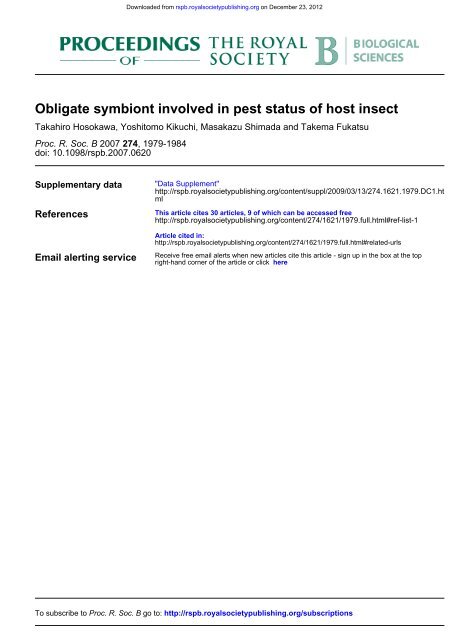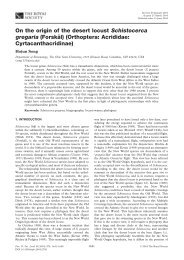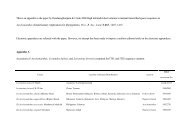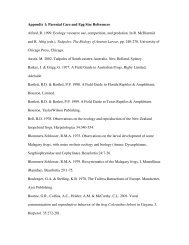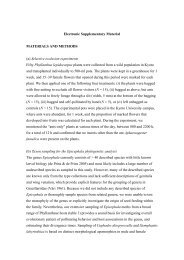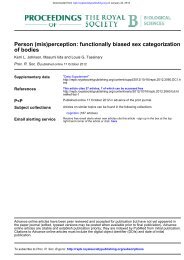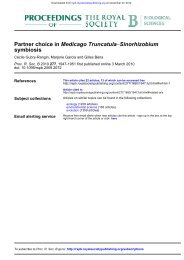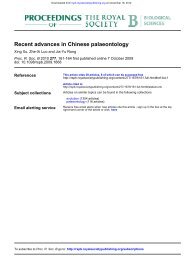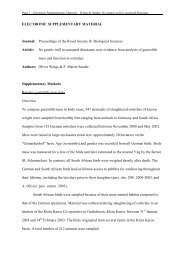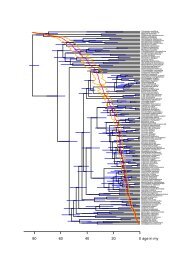Obligate symbiont involved in pest status of host insect
Obligate symbiont involved in pest status of host insect
Obligate symbiont involved in pest status of host insect
Create successful ePaper yourself
Turn your PDF publications into a flip-book with our unique Google optimized e-Paper software.
<strong>Obligate</strong> <strong>symbiont</strong> <strong><strong>in</strong>volved</strong> <strong>in</strong> <strong>pest</strong> <strong>status</strong> <strong>of</strong> <strong>host</strong> <strong>in</strong>sect<br />
Takahiro Hosokawa, Yoshitomo Kikuchi, Masakazu Shimada and Takema Fukatsu<br />
Proc. R. Soc. B 2007 274,<br />
1979-1984<br />
doi: 10.1098/rspb.2007.0620<br />
Supplementary data<br />
References<br />
Email alert<strong>in</strong>g service<br />
Downloaded from<br />
rspb.royalsocietypublish<strong>in</strong>g.org on December 23, 2012<br />
"Data Supplement"<br />
http://rspb.royalsocietypublish<strong>in</strong>g.org/content/suppl/2009/03/13/274.1621.1979.DC1.ht<br />
ml<br />
This article cites 30 articles, 9 <strong>of</strong> which can be accessed free<br />
http://rspb.royalsocietypublish<strong>in</strong>g.org/content/274/1621/1979.full.html#ref-list-1<br />
Article cited <strong>in</strong>:<br />
http://rspb.royalsocietypublish<strong>in</strong>g.org/content/274/1621/1979.full.html#related-urls<br />
Receive free email alerts when new articles cite this article - sign up <strong>in</strong> the box at the top<br />
right-hand corner <strong>of</strong> the article or click here<br />
To subscribe to Proc. R. Soc. B go to: http://rspb.royalsocietypublish<strong>in</strong>g.org/subscriptions
<strong>Obligate</strong> <strong>symbiont</strong> <strong><strong>in</strong>volved</strong> <strong>in</strong> <strong>pest</strong> <strong>status</strong><br />
<strong>of</strong> <strong>host</strong> <strong>in</strong>sect<br />
Takahiro Hosokawa 1,2 , Yoshitomo Kikuchi 1,3 , Masakazu Shimada 2<br />
and Takema Fukatsu 1,2, *<br />
1 Institute for Biological Resources and Functions, National Institute <strong>of</strong> Advanced Industrial Science and Technology (AIST),<br />
Tsukuba 305-8566, Japan<br />
2 Department <strong>of</strong> Systems Sciences, University <strong>of</strong> Tokyo, Tokyo 153-8902, Japan<br />
3 Department <strong>of</strong> Molecular and Cell Biology, University <strong>of</strong> Connecticut, Storrs, CT 06269-3125, USA<br />
The orig<strong>in</strong> <strong>of</strong> specific <strong>in</strong>sect genotypes that enable efficient use <strong>of</strong> agricultural plants is an important subject<br />
not only <strong>in</strong> applied fields like <strong>pest</strong> control and management but also <strong>in</strong> basic discipl<strong>in</strong>es like evolutionary<br />
biology. Conventionally, it has been presupposed that such <strong>pest</strong>-related ecological traits are attributed to<br />
genes encoded <strong>in</strong> the <strong>in</strong>sect genomes. Here, however, we report that <strong>pest</strong> <strong>status</strong> <strong>of</strong> an <strong>in</strong>sect is pr<strong>in</strong>cipally<br />
determ<strong>in</strong>ed by <strong>symbiont</strong> genotype rather than by <strong>in</strong>sect genotype. A <strong>pest</strong> st<strong>in</strong>kbug species, Megacopta<br />
punctatissima, performed well on crop legumes, while a closely related non-<strong>pest</strong> species, Megacopta<br />
cribraria, suffered low egg hatch rate on the plants. When their obligate gut symbiotic bacteria were<br />
experimentally exchanged between the species, their performance on the crop legumes was, strik<strong>in</strong>gly,<br />
completely reversed: the <strong>pest</strong> species suffered low egg hatch rate, whereas the non-<strong>pest</strong> species restored<br />
normal egg hatch rate and showed good performance. The low egg hatch rates were attributed to nymphal<br />
mortality before or upon hatch<strong>in</strong>g, which were associated with the <strong>symbiont</strong> from the non-<strong>pest</strong> st<strong>in</strong>kbug<br />
irrespective <strong>of</strong> the <strong>host</strong> <strong>in</strong>sect species. Our f<strong>in</strong>d<strong>in</strong>g sheds new light on the evolutionary orig<strong>in</strong> <strong>of</strong> <strong>in</strong>sect <strong>pest</strong>s,<br />
potentially lead<strong>in</strong>g to novel approaches to <strong>pest</strong> control and management.<br />
Keywords: Megacopta punctatissima; Megacopta cribraria; Candidatus Ishikawaella capsulata;<br />
<strong>symbiont</strong> capsule; plant adaptation; <strong>pest</strong> evolution<br />
1. INTRODUCTION<br />
In many herbivorous <strong>in</strong>sects, different populations <strong>of</strong> the<br />
same species <strong>of</strong>ten use different food plants, which are<br />
referred to as <strong>host</strong> races, biotypes or ecotypes. Formation<br />
<strong>of</strong> such <strong>in</strong>traspecific plant specialization must have evolved<br />
through acquisition <strong>of</strong> a new food plant by a local<br />
population <strong>of</strong> the <strong>in</strong>sect. In the case that the new food<br />
plant is an agricultural plant, the <strong>in</strong>sect population will be<br />
recognized as an emergent <strong>pest</strong>. Hence, the orig<strong>in</strong> <strong>of</strong><br />
specific <strong>in</strong>sect genotypes that enable efficient use <strong>of</strong><br />
agricultural plants is an important subject not only <strong>in</strong><br />
applied fields like <strong>pest</strong> control and management but also <strong>in</strong><br />
basic discipl<strong>in</strong>es like evolutionary biology (Via 1990;<br />
Berlocher & Feder 2002; Karban & Agrawal 2002; Coyne &<br />
Orr 2004; Shoonhoven et al. 2005). Conventionally, it<br />
has been presupposed that such ecological traits are<br />
attributed to genes encoded <strong>in</strong> the <strong>in</strong>sect genomes (Feder<br />
et al.1988; Hawthorne & Via 2001).<br />
However, recent studies have revealed that facultative<br />
bacterial <strong>symbiont</strong>s may substantially affect various ecological<br />
traits <strong>of</strong> herbivorous <strong>in</strong>sects. For example, several species<br />
<strong>of</strong> facultative <strong>symbiont</strong>s play important biological roles for<br />
the pea aphid Acyrthosiphon pisum <strong>in</strong> specific ecological<br />
* Author and address for correspondence: Institute for Biological<br />
Resources and Functions, National Institute <strong>of</strong> Advanced Industrial<br />
Science and Technology (AIST), Tsukuba 305-8566, Japan<br />
(t-fukatsu@aist.go.jp).<br />
Electronic supplementary material is available at http://dx.doi.org/10.<br />
1098/rspb.2007.0620 or via http://www.journals.royalsoc.ac.uk.<br />
Received 10 May 2007<br />
Accepted 25 May 2007<br />
Downloaded from<br />
rspb.royalsocietypublish<strong>in</strong>g.org on December 23, 2012<br />
Proc. R. Soc. B (2007) 274, 1979–1984<br />
doi:10.1098/rspb.2007.0620<br />
Published onl<strong>in</strong>e 13 June 2007<br />
contexts, <strong>in</strong>clud<strong>in</strong>g tolerance to high temperature (Montllor<br />
et al.2002; Russell & Moran 2006), resistance to parasitoid<br />
wasps (Oliver et al. 2003, 2005), resistance to pathogenic<br />
fungi (Scarborough et al. 2005), broaden<strong>in</strong>g <strong>of</strong> food plant<br />
range (Tsuchida et al. 2004), and others. Here, an idea arises<br />
that the <strong>symbiont</strong> could be <strong><strong>in</strong>volved</strong> <strong>in</strong> emergence <strong>of</strong> <strong>in</strong>sect<br />
<strong>pest</strong>. However, although many <strong>pest</strong> <strong>in</strong>sects <strong>of</strong> agricultural,<br />
economical and medical importance are known to be<br />
associated with bacterial <strong>symbiont</strong>s (Bourtzis & Miller<br />
2003, 2006), there have been no studies demonstrat<strong>in</strong>g<br />
that the <strong>symbiont</strong> is responsible for <strong>pest</strong> <strong>status</strong> <strong>of</strong> its<br />
<strong>host</strong> <strong>in</strong>sect.<br />
Many st<strong>in</strong>kbugs (Insecta: Heteroptera) are, by suck<strong>in</strong>g<br />
plant sap and tissues, known as notorious agricultural<br />
<strong>pest</strong>s (Schaefer & Panizzi 2000). These plant-feed<strong>in</strong>g<br />
st<strong>in</strong>kbugs are generally <strong>in</strong> close association with gut<br />
symbiotic bacteria: they have a specialized midgut section<br />
bear<strong>in</strong>g a number <strong>of</strong> caecal evag<strong>in</strong>ations, <strong>in</strong> which a<br />
copious amount <strong>of</strong> <strong>symbiont</strong> is harboured (Buchner<br />
1965). When experimentally deprived <strong>of</strong> the <strong>symbiont</strong>,<br />
<strong>host</strong> st<strong>in</strong>kbugs suffer retarded growth and high mortality<br />
(Buchner 1965; Abe et al. 1995; Fukatsu & Hosokawa<br />
2002; Hosokawa et al. 2006). Probably the <strong>host</strong> st<strong>in</strong>kbugs<br />
are provided by the <strong>symbiont</strong>s with essential nutrients that<br />
are lack<strong>in</strong>g <strong>in</strong> their diet, as aphids are nutritionally<br />
dependent on the endocellular <strong>symbiont</strong> Buchnera aphidicola<br />
(Douglas 1989; Baumann et al. 2000).<br />
St<strong>in</strong>kbugs <strong>of</strong> the family Plataspidae harbour an obligate<br />
g-proteobacterial <strong>symbiont</strong> ‘Candidatus Ishikawaella<br />
capsulata’ <strong>in</strong> the cavity <strong>of</strong> crypt-bear<strong>in</strong>g posterior midgut<br />
1979 This journal is q 2007 The Royal Society
1980 T. Hosokawa et al. Symbiont-mediated <strong>pest</strong> <strong>status</strong> <strong>of</strong> <strong>host</strong> <strong>in</strong>sect<br />
(Hosokawa et al.2006). The plataspid st<strong>in</strong>kbugs have been<br />
known for their unique mechanism for vertical transmission<br />
called ‘<strong>symbiont</strong> capsule’. When adult females lay eggs on<br />
their <strong>host</strong> plant, small brownish particles are always<br />
deposited under the egg mass. The particles encase a<br />
copious amount <strong>of</strong> the <strong>symbiont</strong> <strong>in</strong>side, and hatchl<strong>in</strong>gs from<br />
the eggs orally acquire the <strong>symbiont</strong> from the capsule<br />
(Schneider 1940; Müller 1956; Fukatsu & Hosokawa<br />
2002; Hosokawa et al. 2005, 2006; figure 1a; electronic<br />
supplementary material, movie 1). When deprived <strong>of</strong><br />
the <strong>symbiont</strong> capsule, the <strong>symbiont</strong>-free <strong>in</strong>sects suffer<br />
abnormal coloration, retarded growth, smaller body size,<br />
higher mortality and sterility (Müller 1956; Fukatsu &<br />
Hosokawa 2002; Hosokawa et al. 2006). Hence, despite<br />
the extracellular location <strong>in</strong> the gut cavity, the <strong>symbiont</strong>s<br />
are regarded as obligate mutualistic associates for the <strong>host</strong><br />
st<strong>in</strong>kbugs. The <strong>symbiont</strong> phylogeny shows a perfect<br />
agreement with the <strong>host</strong> phylogeny, <strong>in</strong>dicat<strong>in</strong>g strict <strong>host</strong>–<br />
<strong>symbiont</strong> cospeciation over evolutionary time (Hosokawa<br />
et al. 2006). A number <strong>of</strong> plataspid species have been<br />
reported as <strong>pest</strong>s <strong>of</strong> various legumes and other agricultural<br />
plants (Tomokuni 1993; Schaefer & Panizzi 2000).<br />
In this study, by mak<strong>in</strong>g use <strong>of</strong> the unique transmission<br />
system mediated by <strong>symbiont</strong> capsules, we experimentally<br />
demonstrated that <strong>pest</strong> <strong>status</strong> <strong>of</strong> a plataspid st<strong>in</strong>kbug is<br />
determ<strong>in</strong>ed by the <strong>symbiont</strong> genotype rather than by the<br />
<strong>in</strong>sect genotype.<br />
2. MATERIAL AND METHODS<br />
(a) Insect sampl<strong>in</strong>g and rear<strong>in</strong>g<br />
Freshly laid egg masses <strong>of</strong> Megacopta punctatissima were<br />
collected from Pueraria lobata at Tsukuba, Ibaraki, Japan. Egg<br />
masses <strong>of</strong> Megacopta cribraria were obta<strong>in</strong>ed from sexually<br />
mature females that had been collected from Pueraria<br />
montana at Naha, Ok<strong>in</strong>awa, Japan. Each <strong>of</strong> the field-collected<br />
females <strong>of</strong> M. cribraria was allowed to oviposit <strong>in</strong> a Petri dish<br />
conta<strong>in</strong><strong>in</strong>g several pea pods (Pisum sativum). To avoid<br />
pseudoreplication, all <strong>of</strong> the egg masses <strong>of</strong> M. cribraria used<br />
for experiments were derived from different females. These<br />
<strong>in</strong>sects were ma<strong>in</strong>ta<strong>in</strong>ed <strong>in</strong> climatic chambers at 258C <strong>in</strong>a<br />
long-day regimen (16 h light–8 h dark).<br />
(b) Experimental manipulation<br />
Only newly laid egg masses conta<strong>in</strong><strong>in</strong>g 24 or more eggs and 7<br />
or more capsules were used for experiments. All <strong>of</strong> these egg<br />
masses exhibited normal egg hatch rates rang<strong>in</strong>g from 80 to<br />
100%. To m<strong>in</strong>imize confound<strong>in</strong>g effects <strong>of</strong> the <strong>in</strong>sect genetic<br />
backgrounds, two experimental groups were produced from<br />
each <strong>of</strong> the egg masses for control treatment and <strong>symbiont</strong>replac<strong>in</strong>g<br />
treatment, respectively. Each <strong>of</strong> the egg masses was<br />
separated <strong>in</strong>to <strong>in</strong>dividual eggs and capsules by us<strong>in</strong>g f<strong>in</strong>e<br />
forceps under a b<strong>in</strong>ocular microscope. To sterilize remnant<br />
<strong>symbiont</strong> cells possibly adher<strong>in</strong>g to the egg surface, the eggs<br />
were treated with 70% ethanol for 5 m<strong>in</strong>, 4% formal<strong>in</strong> for<br />
30 m<strong>in</strong> and 70% ethanol for 10 s, and were dried <strong>in</strong> air. For<br />
control treatment, randomly chosen 12 eggs and 7 capsules<br />
from an egg mass were realigned like a natural egg mass and<br />
were glued on a piece <strong>of</strong> filter paper. For <strong>symbiont</strong>-replac<strong>in</strong>g<br />
treatment, the other 12 eggs from the egg mass were realigned<br />
with 7 heterospecific capsules <strong>in</strong> the same way. These<br />
experimental egg masses were <strong>in</strong>dividually kept <strong>in</strong> a Petri<br />
dish with a wet cotton ball.<br />
Proc. R. Soc. B (2007)<br />
Downloaded from<br />
rspb.royalsocietypublish<strong>in</strong>g.org on December 23, 2012<br />
(c) Fitness measurement<br />
For each <strong>of</strong> the st<strong>in</strong>kbug species, nymphs from 18 sets<br />
(families) <strong>of</strong> a pair <strong>of</strong> experimental egg masses were subjected<br />
to fitness measurements. After a day <strong>of</strong> egg hatch, 10 nymphs<br />
were randomly chosen from each <strong>of</strong> the egg masses and reared<br />
on a potted soya bean plant (Glyc<strong>in</strong>e max). These <strong>in</strong>sects were<br />
exam<strong>in</strong>ed for growth rate (nymphal period), adult emergence<br />
rate (%) and adult body size (thorax width).<br />
Adult <strong>in</strong>sects that emerged from the 17 out <strong>of</strong> 18 sets for<br />
M. punctatissima and those from the 16 out <strong>of</strong> 18 sets for<br />
M. cribraria were exam<strong>in</strong>ed for their reproductive performance.<br />
Each <strong>of</strong> several (1–5) pairs <strong>of</strong> a male and a female<br />
from the same egg masses was separately kept <strong>in</strong> a Petri dish<br />
and provided with pea pods. The dishes were <strong>in</strong>spected<br />
everyday and the pea pods were periodically replaced with<br />
fresh ones. All egg masses laid by each <strong>of</strong> the females were<br />
collected dur<strong>in</strong>g 30 days after the first oviposition. Each <strong>of</strong><br />
the egg masses was kept <strong>in</strong> a Petri dish and <strong>in</strong>spected, and the<br />
eggs were categorized <strong>in</strong>to hatched eggs, fertilized unhatched<br />
eggs and unfertilized eggs. Nymphal body segments and/or<br />
red eyespots were seen <strong>in</strong> fertilized eggs but not <strong>in</strong> unfertilized<br />
eggs. Nymphs that died dur<strong>in</strong>g hatch<strong>in</strong>g were counted as<br />
fertilized unhatched eggs. For each <strong>of</strong> the females, total<br />
number <strong>of</strong> eggs, egg fertilization rate (%) and egg hatch rate<br />
(%) were calculated. Females that died without produc<strong>in</strong>g<br />
eggs were excluded from the analyses. Proportions <strong>of</strong> such<br />
females were statistically not different between the control<br />
and <strong>symbiont</strong>-replaced treatments (5 out <strong>of</strong> 62 control<br />
females versus 5 out <strong>of</strong> 58 <strong>symbiont</strong>-replaced females <strong>in</strong><br />
M. punctatissima, Fisher’s exact probability test, pZ1; 4 out <strong>of</strong><br />
45 control females versus 6 out <strong>of</strong> 43 <strong>symbiont</strong>-replaced females<br />
<strong>in</strong> M. cribraria, Fisher’s exact probability test, pZ0.517).<br />
(d) Clon<strong>in</strong>g and sequenc<strong>in</strong>g<br />
DNA was extracted from isolated <strong>symbiont</strong> capsules by us<strong>in</strong>g<br />
a QIAamp tissue m<strong>in</strong>i kit (QIAGEN), from which a 1.7 kbp<br />
segment <strong>of</strong> eubacterial groE gene was amplified by polymerase<br />
cha<strong>in</strong> reaction (PCR) with primers Gro-F1 (5 0 -ATG<br />
GCA GCW AAA GAC GTA AAT TYG G-3 0 ) and Gro-R1<br />
(5 0 -TTA CAT CAT KCC GCC CAT GC-3 0 ). The PCR<br />
product was cloned and sequenced as described previously<br />
(Kikuchi & Fukatsu 2003). The groE sequences <strong>of</strong> the<br />
<strong>symbiont</strong> from M. punctatissima and M. cribraria were<br />
deposited <strong>in</strong> the DNA Data Bank <strong>of</strong> Japan database with<br />
accession numbers AB231904 and AB264337, respectively.<br />
(e) Symbiont quantification<br />
We constructed seven and six sets <strong>of</strong> control and <strong>symbiont</strong>replaced<br />
egg masses for M. punctatissima and M. cribraria,<br />
respectively. After a day <strong>of</strong> egg hatch, 10 nymphs from each <strong>of</strong><br />
the experimental egg masses were <strong>in</strong>dividually subjected to<br />
DNA extraction and <strong>symbiont</strong> quantification. The <strong>symbiont</strong><br />
titres were measured <strong>in</strong> terms <strong>of</strong> bacterial groE gene copies by<br />
us<strong>in</strong>g a quantitative PCR technique as described previously<br />
(Koga et al. 2003). S<strong>in</strong>ce the <strong>symbiont</strong> groE gene sequences<br />
were completely identical between M. punctatissima and<br />
M. cribraria (accession nos. AB231904 and AB264337,<br />
respectively), the same primers MEGAgro-F1 (5 0 -GGT<br />
GCT GCC ACT GAA GTT GA-3 0 ) and MEGAgro-R1<br />
(5 0 -CCG CTA CAC GCA CTA ACG C-3 0 ) and the same<br />
probe MEGAgro-P1 (5 0 -TGA AGA AGG TGT CGT TCC<br />
CGG AGG-3 0 ) were used.
(f ) Statistics<br />
To statistically evaluate the differences between the control<br />
and the <strong>symbiont</strong>-replac<strong>in</strong>g treatment, the Wilcoxon signedrank<br />
test was adopted for adult emergence rate, and a<br />
generalized l<strong>in</strong>ear model (GLM) framework was applied to<br />
the other fitness parameters (McCullagh & Nelder 1989). In<br />
the GLM analyses, for egg fertilization rates and egg hatch<br />
rates, we used b<strong>in</strong>om<strong>in</strong>al error or, if overdispersion was<br />
detected, quasi-b<strong>in</strong>om<strong>in</strong>al error (Crawley 1993, 2005),<br />
whereas for the other data, an appropriate error distribution<br />
was selected from normal, Poisson, gamma, <strong>in</strong>verse normal<br />
and negative b<strong>in</strong>omial errors accord<strong>in</strong>g to the Akaike<br />
<strong>in</strong>formation criterion. Two terms, namely <strong>symbiont</strong> types<br />
(control and replaced) and family, were <strong>in</strong>cluded <strong>in</strong> the<br />
models, and the effects <strong>of</strong> the terms were evaluated by an<br />
analysis <strong>of</strong> deviance (Crawley 1993). All the statistical<br />
analyses were conducted by us<strong>in</strong>g a s<strong>of</strong>tware R v. 2.3.1<br />
(R Development Core Team 2006).<br />
3. RESULTS AND DISCUSSION<br />
(a) Closely related <strong>pest</strong> and non-<strong>pest</strong> plataspid<br />
st<strong>in</strong>kbugs<br />
The plataspid st<strong>in</strong>kbug M. punctatissima (figure 1b) is<br />
commonly found <strong>in</strong> the ma<strong>in</strong>land Japan, while a closely<br />
related st<strong>in</strong>kbug M. cribraria (figure 1c) is distributed across<br />
the southwestern islands <strong>of</strong> Japan. They are classified <strong>in</strong>to<br />
different species morphologically: e.g. M. cribraria is smaller<br />
<strong>in</strong> size and paler <strong>in</strong> colour than M. punctatissima (figure 1b,c).<br />
However, they are no doubt close genetically and biologically:<br />
their mitochondrial 16S rRNA genes showed 99.3%<br />
(1565/1576 nucleotide sites) sequence identity (Hosokawa<br />
et al. 2006); reciprocal crosses between the species resulted<br />
<strong>in</strong> F 1 <strong>of</strong>fspr<strong>in</strong>g with <strong>in</strong>termediate morphological traits; and<br />
crosses between the F 1 <strong>in</strong>sects could produce F 2 <strong>of</strong>fspr<strong>in</strong>g<br />
(T. Hosokawa 2005, unpublished data). The ma<strong>in</strong> <strong>host</strong><br />
plants <strong>of</strong> M. punctatissima and M. cribraria are wild<br />
legum<strong>in</strong>ous v<strong>in</strong>es P. lobata and P. montana, respectively,<br />
while these <strong>in</strong>sects also use other legum<strong>in</strong>ous plants<br />
(Tomokuni 1993). In particular, M. punctatissima has been<br />
known as <strong>pest</strong> <strong>of</strong> soya bean, pea and other legumes. The<br />
<strong>in</strong>sects <strong>of</strong>ten gregariously <strong>in</strong>fest the plants and damage<br />
the crops, and without spray<strong>in</strong>g, lay eggs and proliferate <strong>in</strong><br />
the legume fields (Kono 1990; Tomokuni 1993; Endo et al.<br />
2002). On the other hand, M. cribraria scarcely causes such<br />
serious problems <strong>in</strong> Japan, although <strong>in</strong>festation on soya<br />
bean and other legumes has been occasionally reported<br />
(Tomokuni 1993). What is the basis <strong>of</strong> the difference<br />
between the <strong>pest</strong> and non-<strong>pest</strong> <strong>in</strong>sects?<br />
(b) Fitness parameters <strong>of</strong> <strong>pest</strong> and non-<strong>pest</strong><br />
st<strong>in</strong>kbugs on crop legumes<br />
In order to address the question, we evaluated the general<br />
performance <strong>of</strong> the <strong>pest</strong> species M. punctatissima and the<br />
non-<strong>pest</strong> species M. cribraria on potted soya bean plants<br />
and pea pods. Both species normally grew to adult and laid<br />
eggs (figure 2b–e). The eggs were certa<strong>in</strong>ly fertilized<br />
(figure 2f ). However, egg hatch rates were strik<strong>in</strong>gly<br />
different between the species; around 80% <strong>in</strong><br />
M. punctatissima <strong>in</strong> contrast to only 50% <strong>in</strong> M. cribraria<br />
(figure 2g). The difference was statistically significant<br />
(median test, p!0.0001). A characteristic mortality<br />
symptom was observed <strong>in</strong> the egg masses <strong>of</strong> M. cribraria,<br />
where<strong>in</strong> many nymphs failed to escape from the eggshell<br />
Proc. R. Soc. B (2007)<br />
Downloaded from<br />
rspb.royalsocietypublish<strong>in</strong>g.org on December 23, 2012<br />
Symbiont-mediated <strong>pest</strong> <strong>status</strong> <strong>of</strong> <strong>host</strong> <strong>in</strong>sect T. Hosokawa et al. 1981<br />
and died (figure 3b). These dead nymphs were generally<br />
frail <strong>in</strong> size and morphology, probably due to developmental<br />
abnormality (data not shown).<br />
(c) Low egg hatch rate <strong>of</strong> non-<strong>pest</strong> st<strong>in</strong>kbug<br />
on crop legumes<br />
These results <strong>in</strong>dicated that the non-<strong>pest</strong> species<br />
M. cribraria suffers low egg hatch rate on the crop legumes<br />
while the <strong>pest</strong> species M. punctatissima does not, which is<br />
probably relevant to their different <strong>pest</strong> <strong>status</strong>. The crop<br />
legumes, although used under the laboratory condition,<br />
are unsuitable <strong>host</strong> plants for M. cribraria.<br />
(d) Experimental <strong>symbiont</strong> exchange between<br />
<strong>pest</strong> and non-<strong>pest</strong> st<strong>in</strong>kbugs<br />
In most <strong>of</strong> the obligate endosymbiotic systems <strong>in</strong> <strong>in</strong>sects,<br />
such as those <strong>in</strong> aphids and tsetse flies, the <strong>host</strong> and the<br />
<strong>symbiont</strong> are structurally, functionally and developmentally<br />
<strong>in</strong>tegrated <strong>in</strong>to an almost <strong>in</strong>separable biological entity<br />
(Buchner 1965; Douglas 1989; Baumann et al. 2000;<br />
Braendle et al. 2003). Thus, it has been practically<br />
impossible to manipulate these obligate <strong>host</strong>–<strong>symbiont</strong><br />
associations experimentally. However, the unique capsulemediated<br />
transmission system <strong>in</strong> the plataspid st<strong>in</strong>kbugs<br />
enabled us to attempt such experiments despite the obligate<br />
nature <strong>of</strong> the symbiosis. The <strong>host</strong> eggs and the <strong>symbiont</strong><br />
capsules were separated by us<strong>in</strong>g forceps under a b<strong>in</strong>ocular<br />
microscope, and the eggs <strong>of</strong> M. punctatissima were comb<strong>in</strong>ed<br />
with the capsules <strong>of</strong> M. cribraria, and vice versa. The<br />
hatchl<strong>in</strong>gs readily accepted the heterospecific capsules and<br />
<strong>in</strong>gested the content. Quantitative PCR assays confirmed<br />
that the nymphs certa<strong>in</strong>ly acquired the heterospecific<br />
<strong>symbiont</strong> cells, and the acquired amount was equivalent to<br />
that <strong>of</strong> the conspecific <strong>symbiont</strong> cells (figure 2a).<br />
(e) Fitness parameters <strong>of</strong> <strong>pest</strong> and non-<strong>pest</strong><br />
st<strong>in</strong>kbugs on crop legumes after <strong>symbiont</strong><br />
exchange<br />
The <strong>symbiont</strong>-replaced <strong>in</strong>sects normally grew to adult<br />
and laid eggs (figure 2b–e). Although <strong>symbiont</strong>-elim<strong>in</strong>ated<br />
adults <strong>of</strong> these st<strong>in</strong>kbugs were reported to severely suffer<br />
abnormal coloration and reduced body size (Fukatsu &<br />
Hosokawa 2002; Hosokawa et al. 2006), the <strong>symbiont</strong>replaced<br />
adults were almost <strong>in</strong>dist<strong>in</strong>guishable from the<br />
control adults (figure 1b,c), except that growth rate and<br />
body size <strong>of</strong> M. cribraria were slightly but significantly<br />
reduced <strong>in</strong> association with the <strong>symbiont</strong> replacement<br />
(figure 2c,d ). In both the species, the eggs laid by the<br />
<strong>symbiont</strong>-replaced adults were certa<strong>in</strong>ly fertilized<br />
(figure 2f ), but egg hatch rates were strik<strong>in</strong>gly different<br />
between the species; around 90% <strong>in</strong> M. cribraria <strong>in</strong><br />
contrast to only 25% <strong>in</strong> M. punctatissima (figure 2g).<br />
The difference was statistically significant (median test,<br />
p!0.0001). In the egg masses deposited by the <strong>symbiont</strong>replaced<br />
females <strong>of</strong> M. punctatissima, many nymphs failed<br />
to escape from the eggshell and died (figure 3c), which was<br />
rem<strong>in</strong>iscent <strong>of</strong> the symptom observed with the egg masses<br />
deposited by the normal females <strong>of</strong> M. cribraria (figure 3b).<br />
(f ) Pest <strong>status</strong> <strong>of</strong> Megacopta punctatissima<br />
determ<strong>in</strong>ed by <strong>symbiont</strong> genotype<br />
In summary, the fitness measurements on the crop<br />
legumes <strong>in</strong> comb<strong>in</strong>ation with the <strong>symbiont</strong>-replac<strong>in</strong>g<br />
experiments demonstrated that (i) M. punctatissima that
1982 T. Hosokawa et al. Symbiont-mediated <strong>pest</strong> <strong>status</strong> <strong>of</strong> <strong>host</strong> <strong>in</strong>sect<br />
(a)<br />
(b) M. punctatissima (c)<br />
M. punctatissima<br />
M. cribraria<br />
control replaced control replaced<br />
Figure 1. Pest and non-<strong>pest</strong> plataspid st<strong>in</strong>kbugs. (a) Newborn<br />
nymphs <strong>of</strong> Megacopta punctatissima prob<strong>in</strong>g capsules for<br />
<strong>symbiont</strong> acquisition. Arrows and arrowheads <strong>in</strong>dicate<br />
<strong>symbiont</strong> capsules and eggshells, respectively. (b) Pest species<br />
M. punctatissima. (c) Non-<strong>pest</strong> species Megacopta cribraria.<br />
Normal adult females with their orig<strong>in</strong>al <strong>symbiont</strong> (control)<br />
and manipulated adult females whose <strong>symbiont</strong> was<br />
experimentally replaced by the heterospecific one (replaced)<br />
are shown. Scale bars, 1 mm.<br />
orig<strong>in</strong>ally exhibited a normal egg hatch rate suffered a low<br />
egg hatch rate when <strong>in</strong>fected with the <strong>symbiont</strong> from<br />
M. cribraria, (ii) M. cribraria that orig<strong>in</strong>ally exhibited a low<br />
egg hatch rate restored a normal egg hatch rate when<br />
<strong>in</strong>fected with the <strong>symbiont</strong> from M. punctatissima, (iii) the<br />
mortality symptom <strong>in</strong> hatchl<strong>in</strong>gs was similar irrespective<br />
<strong>of</strong> the st<strong>in</strong>kbug species and was associated with the<br />
<strong>symbiont</strong> from M. cribraria, and (iv) hence, the normal<br />
egg hatch rate and the good performance <strong>of</strong> the st<strong>in</strong>kbugs<br />
on the crop legumes were attributed to the <strong>symbiont</strong> from<br />
M. punctatissima. These results strongly suggest that the<br />
<strong>pest</strong> <strong>status</strong> <strong>of</strong> M. punctatissima is pr<strong>in</strong>cipally determ<strong>in</strong>ed by<br />
the <strong>symbiont</strong> genotype rather than by the <strong>in</strong>sect genotype.<br />
(g) Evolutionary orig<strong>in</strong> <strong>of</strong> <strong>pest</strong>-related <strong>symbiont</strong><br />
genotype?<br />
The mechanism whereby the <strong>symbiont</strong> from M. punctatissima<br />
can support the normal development <strong>of</strong> the <strong>host</strong><br />
<strong>in</strong>sects on the crop legumes is unknown. In plataspid<br />
st<strong>in</strong>kbugs, the <strong>host</strong> <strong>in</strong>sect phylogeny perfectly agreed with<br />
the <strong>symbiont</strong> phylogeny, <strong>in</strong>dicat<strong>in</strong>g stable <strong>host</strong>–<strong>symbiont</strong><br />
association over evolutionary time (Hosokawa et al. 2006).<br />
Among the plataspid st<strong>in</strong>kbugs phylogenetically analysed,<br />
M. punctatissima and M. cribraria are the closest<br />
genetically (Hosokawa et al. 2006). The <strong>symbiont</strong>s from<br />
M. punctatissima and M. cribraria are also very close<br />
genetically as their <strong>host</strong> <strong>in</strong>sects are: their 16S rRNA genes<br />
showed 99.9% (1308/1309 nucleotide sites) sequence<br />
identity, and their genome size was estimated to be<br />
0.82 Mbp <strong>in</strong> common (Hosokawa et al. 2006). It appears<br />
probable, although speculative, that mutations occurr<strong>in</strong>g<br />
<strong>in</strong> the <strong>symbiont</strong> genomes after the <strong>host</strong> speciation have<br />
modulated their capability <strong>of</strong> us<strong>in</strong>g different <strong>host</strong> plants,<br />
which predisposed the <strong>host</strong> <strong>in</strong>sects to potentially become<br />
<strong>pest</strong>s or not.<br />
Proc. R. Soc. B (2007)<br />
Downloaded from<br />
rspb.royalsocietypublish<strong>in</strong>g.org on December 23, 2012<br />
(a)<br />
(b)<br />
(c)<br />
(d)<br />
(e)<br />
( f )<br />
(g)<br />
<strong>symbiont</strong> titer (×10 7 )<br />
adult emergence (%)<br />
nymphal period (days)<br />
thorax width (mm)<br />
total no. <strong>of</strong> eggs<br />
fertilized eggs (%)<br />
hatched eggs (%)<br />
2<br />
1<br />
0<br />
100<br />
50<br />
0<br />
48<br />
44<br />
40<br />
36<br />
32<br />
3.9<br />
3.7<br />
3.5<br />
3.3<br />
3.1<br />
200<br />
150<br />
100<br />
50<br />
0<br />
100<br />
75<br />
50<br />
25<br />
0<br />
100<br />
75<br />
50<br />
25<br />
0<br />
M. punctatissima<br />
70<br />
18<br />
n.s.<br />
57<br />
control<br />
n.s.<br />
70 1 60<br />
n.s.<br />
n.s. n.s.<br />
100<br />
18 50 18 18<br />
0<br />
control replaced control replaced<br />
p < 0.05 p < 0.0001<br />
86 77<br />
91 92<br />
3.0<br />
77 78<br />
92<br />
88<br />
female male<br />
2.8<br />
female male<br />
n.s.<br />
p < 0.0001<br />
n.s.<br />
3<br />
2<br />
0<br />
48<br />
44<br />
40<br />
86 79 91 93<br />
36 78 81<br />
97<br />
93<br />
female male<br />
32<br />
female male<br />
n.s.<br />
3.4<br />
n.s.<br />
n.s. 3.2<br />
p < 0.001<br />
150<br />
100<br />
M. cribraria<br />
n.s.<br />
57 53 50<br />
41 37<br />
control replaced<br />
0<br />
control replaced<br />
n.s. 100<br />
75<br />
n.s.<br />
57 53 50<br />
25<br />
41 37<br />
control replaced<br />
0<br />
control replaced<br />
p < 0.0001<br />
60<br />
37<br />
53<br />
41<br />
replaced control replaced<br />
Figure 2. Fitness measurements <strong>of</strong> normal and <strong>symbiont</strong>replaced<br />
plataspid st<strong>in</strong>kbugs. (a) Symbiont titre acquired by<br />
newborn nymphs, <strong>in</strong> terms <strong>of</strong> <strong>symbiont</strong> groE gene copies per<br />
<strong>in</strong>sect. (b) Adult emergence rate (%). (c) Growth rate, <strong>in</strong><br />
terms <strong>of</strong> nymphal period (days). (d ) Adult body size, <strong>in</strong> terms<br />
<strong>of</strong> thorax width (mm). (e) Total number <strong>of</strong> eggs produced by<br />
an adult female. ( f ) Fertilization rate <strong>of</strong> eggs (%). (g) Hatch<br />
rate <strong>of</strong> eggs (%). Means and standard deviations are shown.<br />
Sample sizes are <strong>in</strong>dicated on columns. Statistically significant<br />
differences between control treatment and <strong>symbiont</strong>replac<strong>in</strong>g<br />
treatment are shown <strong>in</strong> red.
control<br />
replaced<br />
M. punctatissima<br />
(a) (b)<br />
(c) (d)<br />
M. cribraria<br />
Figure 3. Mortality symptom observed with hatchl<strong>in</strong>gs <strong>of</strong><br />
plataspid st<strong>in</strong>kbugs reared on the crop legumes. (a,c)<br />
Megacopta punctatissima, (b,d ) M. cribraria, (a,b) egg masses<br />
laid by normal females and (c,d ) egg masses laid by <strong>symbiont</strong>replaced<br />
females. Scale bars, 1 mm.<br />
(h) What underlies <strong>symbiont</strong>-mediated fitness<br />
effect on <strong>host</strong> <strong>in</strong>sect: plant-specific difference<br />
or general difference <strong>in</strong> vigour?<br />
For herbivorous <strong>in</strong>sects, be<strong>in</strong>g <strong>pest</strong>s basically requires the<br />
ability to use an alternative suboptimal <strong>host</strong> plant<br />
(Karban & Agrawal 2002; Shoonhoven et al. 2005). For<br />
M. punctatissima and M. cribraria, wild legum<strong>in</strong>ous v<strong>in</strong>es<br />
Pueraria spp. are the ma<strong>in</strong> optimal <strong>host</strong> plants. Both<br />
species perform well on their orig<strong>in</strong>al <strong>host</strong> plant, atta<strong>in</strong><strong>in</strong>g<br />
over 90% egg hatch rates under natural conditions<br />
(T. Hosokawa 2005, unpublished data). Meanwhile,<br />
soya bean and other crop legumes are regarded as auxiliary<br />
suboptimal <strong>host</strong> plants for these <strong>in</strong>sects. We found<br />
that normal M. cribraria and <strong>symbiont</strong>-replaced<br />
M. punctatissima suffer low egg hatch rates on the crop<br />
legumes (figures 2g and 3), <strong>in</strong>dicat<strong>in</strong>g that the <strong>symbiont</strong><br />
from M. cribraria is responsible for the poor performance<br />
<strong>of</strong> the <strong>in</strong>sects on suboptimal <strong>host</strong> plants. In other words,<br />
the <strong>symbiont</strong> from M. punctatissima was superior to the<br />
<strong>symbiont</strong> from M. cribraria <strong>in</strong> support<strong>in</strong>g normal development<br />
<strong>of</strong> the <strong>host</strong> <strong>in</strong>sects on the suboptimal <strong>host</strong> plants.<br />
There are two mechanisms as to how these <strong>symbiont</strong>s<br />
differ <strong>in</strong> their effects on the <strong>host</strong> fitness. One mechanism is<br />
a plant-specific difference, where<strong>in</strong> the <strong>symbiont</strong> from<br />
M. punctatissima physiologically performs better for the<br />
<strong>host</strong> <strong>in</strong>sects than the <strong>symbiont</strong> from M. cribraria<br />
specifically on the suboptimal <strong>host</strong> plants. The other<br />
mechanism is a general difference <strong>in</strong> vigour, where<strong>in</strong> the<br />
<strong>symbiont</strong> from M. punctatissima generally shows better<br />
performance for the <strong>host</strong> <strong>in</strong>sects than the <strong>symbiont</strong> from<br />
M. cribraria, and the difference becomes obvious on the<br />
suboptimal <strong>host</strong> plants but not on the optimal <strong>host</strong> plants.<br />
If the former scenario is true, we should consider the<br />
possibility that the biological trait <strong>of</strong> the <strong>symbiont</strong> from<br />
M. punctatissima might have been selected for <strong>in</strong> the<br />
ma<strong>in</strong>land Japan where the crop legumes are widely<br />
cultivated. On the other hand, if the latter scenario is<br />
true, the possibility becomes less likely, and the difference<br />
might be attributed to more general aspects <strong>of</strong> the<br />
<strong>symbiont</strong> genomes. To verify which <strong>of</strong> these mechanisms<br />
better accounts for the phenomena, further experimental<br />
studies, <strong>in</strong> particular fitness measurements <strong>of</strong> the<br />
Proc. R. Soc. B (2007)<br />
Downloaded from<br />
rspb.royalsocietypublish<strong>in</strong>g.org on December 23, 2012<br />
Symbiont-mediated <strong>pest</strong> <strong>status</strong> <strong>of</strong> <strong>host</strong> <strong>in</strong>sect T. Hosokawa et al. 1983<br />
<strong>symbiont</strong>-manipulated <strong>in</strong>sects on the optimal <strong>host</strong> plants,<br />
are needed.<br />
(i) Plant specialization <strong>of</strong> herbivorous <strong>in</strong>sect<br />
mediated by obligate <strong>symbiont</strong><br />
Recent studies have revealed that some facultative<br />
microbial <strong>symbiont</strong>s substantially affect various ecological<br />
traits <strong>of</strong> herbivorous <strong>in</strong>sects <strong>in</strong>clud<strong>in</strong>g plant specialization<br />
(Montllor et al. 2002; Oliver et al. 2003, 2005; Tsuchida<br />
et al. 2004; Scarborough et al. 2005; Leonardo & Mondor<br />
2006; Russell & Moran 2006). Our discovery <strong>in</strong>dicates<br />
that even obligate <strong>symbiont</strong>s that play essential biological<br />
roles for their <strong>host</strong> may also affect plant specialization, and<br />
suggests that such <strong>symbiont</strong>s could potentially be causal<br />
agents <strong>of</strong> emergent <strong>in</strong>sect <strong>pest</strong>s. It is currently unknown<br />
how prevalent similar cases <strong>of</strong> <strong>symbiont</strong>-mediated plant<br />
specialization are <strong>in</strong> natural and agricultural ecosystems.<br />
In this context, it is <strong>of</strong> both evolutionary and practical<br />
importance to survey the correlation between <strong>symbiont</strong><br />
genotypes and <strong>host</strong> races/biotypes/ecotypes <strong>in</strong> various<br />
<strong>in</strong>sect–microbe symbiotic systems.<br />
(j) Perspective for <strong>pest</strong> control and management<br />
A number <strong>of</strong> agriculturally, economically and medically<br />
notorious <strong>in</strong>sect <strong>pest</strong>s harbour symbiotic micro-organisms<br />
(Bourtzis & Miller 2003, 2006). In some <strong>of</strong> these cases,<br />
the <strong>symbiont</strong>s have been suggested as possible agents for<br />
controll<strong>in</strong>g the <strong>pest</strong>s by us<strong>in</strong>g paratransgenic approach<br />
(Durvasula et al. 1997; Ben Beard et al. 2002), <strong>symbiont</strong>driven<br />
population replacement (Dobson 2003; S<strong>in</strong>k<strong>in</strong>s &<br />
Gould 2006) and <strong>in</strong>compatible <strong>in</strong>sect technique (Zabalou<br />
et al. 2004). Strik<strong>in</strong>gly, it was reported that the most<br />
widely applied biological <strong>in</strong>secticide, Bacillus thur<strong>in</strong>giensis,<br />
is effective to lepidopteran larvae only when the <strong>in</strong>sects<br />
harbour a gut microbial community (Broderick et al.<br />
2006), illum<strong>in</strong>at<strong>in</strong>g pr<strong>of</strong>ound relevance <strong>of</strong> <strong>in</strong>sect gut<br />
bacteria to <strong>pest</strong> control. The gut symbiotic bacteria <strong>of</strong><br />
the plataspid st<strong>in</strong>kbugs provide a model system for<br />
understand<strong>in</strong>g the mechanisms underly<strong>in</strong>g the <strong>symbiont</strong>mediated<br />
<strong>pest</strong> evolution, which would potentially lead to<br />
novel means <strong>of</strong> <strong>pest</strong> control and management. Functional<br />
and genomic analyses <strong>of</strong> the st<strong>in</strong>kbug <strong>symbiont</strong> would lead<br />
to further <strong>in</strong>sights <strong>in</strong>to how the <strong>symbiont</strong>s affect such<br />
ecological traits <strong>of</strong> the <strong>host</strong> <strong>in</strong>sects.<br />
We thank S. Ohno and D. Haraguchi for collect<strong>in</strong>g samples,<br />
and E. Kasuya for statistics. This study was f<strong>in</strong>ancially<br />
supported by the National Institute <strong>of</strong> Advanced Industrial<br />
Science and Technology (AIST) and the 21st COE Program<br />
‘Research Centre for Integrated Science’ (E-5) at the<br />
University <strong>of</strong> Tokyo. T.H. and Y.K. were supported by the<br />
Research Fellowship <strong>of</strong> the Japan Society for the Promotion<br />
<strong>of</strong> Science for Young Scientists.<br />
REFERENCES<br />
Abe, Y., Mishiro, K. & Takanashi, M. 1995 Symbiont <strong>of</strong><br />
brown-w<strong>in</strong>ged green bug, Plautia stali Scott. Jpn J. Appl.<br />
Entomol. Zool. 39, 109–115.<br />
Baumann, P., Moran, N. A. & Baumann, L. 2000<br />
Bacteriocyte-associated endo<strong>symbiont</strong>s <strong>of</strong> <strong>in</strong>sects. In The<br />
prokaryotes (ed. M. Dwork<strong>in</strong>), pp. 1–55. New York, NY:<br />
Spr<strong>in</strong>ger.<br />
Ben Beard, C., Cordon-Rosales, C. & Durvasula, R. V. 2002<br />
Bacterial <strong>symbiont</strong>s <strong>of</strong> the triatom<strong>in</strong>ae and their potential
1984 T. Hosokawa et al. Symbiont-mediated <strong>pest</strong> <strong>status</strong> <strong>of</strong> <strong>host</strong> <strong>in</strong>sect<br />
use <strong>in</strong> control <strong>of</strong> chagas disease transmission. Annu.<br />
Rev. Entomol. 47, 123–141. (doi:10.1146/annurev.ento.<br />
47.091201.145144)<br />
Berlocher, S. H. & Feder, J. L. 2002 Sympatric speciation <strong>in</strong><br />
phytophagous <strong>in</strong>sects: mov<strong>in</strong>g beyond controversy? Annu.<br />
Rev. Entomol. 47, 773–815. (doi:10.1146/annurev.ento.<br />
47.091201.145312)<br />
Bourtzis, K. & Miller, T. A. 2003 Insect symbiosis. Boca Raton,<br />
FL: CRC Press.<br />
Bourtzis, K. & Miller, T. A. 2006 Insect symbiosis II. Boca<br />
Raton, FL: CRC Press.<br />
Braendle, C., Miura, T., Bickel, R., Sh<strong>in</strong>gleton, A. W.,<br />
Kambhampati, S. & Stern, D. L. 2003 Developmental<br />
orig<strong>in</strong> and evolution <strong>of</strong> bacteriocytes <strong>in</strong> the aphid-<br />
Buchnera symbiosis. PLoS Biol. 1, e21. (doi:10.1371/<br />
journal.pbio.0000021)<br />
Broderick, N. A., Raffa, K. F. & Handelsman, J. 2006 Midgut<br />
bacteria required for Bacillus thur<strong>in</strong>giensis <strong>in</strong>secticidal<br />
activity. Proc. Natl Acad. Sci. USA 103, 15 196–15 199.<br />
(doi:10.1073/pnas.0604865103)<br />
Buchner, P. 1965 Endosymbiosis <strong>of</strong> animals with plant<br />
microorganisms. New York, NY: Interscience.<br />
Coyne, J. A. & Orr, H. A. 2004 Speciation. Sunderland, MA:<br />
S<strong>in</strong>auer Associates.<br />
Crawley, M. J. 1993 GLIM for ecologists. Oxford, UK:<br />
Blackwell Scientific.<br />
Crawley, M. J. 2005 Statistics. An <strong>in</strong>troduction us<strong>in</strong>g R.<br />
Chichester, UK: Wiley.<br />
Dobson, S. L. 2003 Revers<strong>in</strong>g Wolbachia-based population<br />
replacement. Trends Parasitol. 19, 128–133. (doi:10.1016/<br />
S1471-4922(03)00002-3)<br />
Douglas, A. E. 1989 Mycetocyte symbiosis <strong>in</strong> <strong>in</strong>sects. Biol.<br />
Rev. 64, 409–434.<br />
Durvasula, R. V., Gumbs, A., Panackal, A., Kruglov, O.,<br />
Aksoy, S., Merrifield, R. B., Richards, F. F. & Beard, C. B.<br />
1997 Prevention <strong>of</strong> <strong>in</strong>sect-borne disease: an approach<br />
us<strong>in</strong>g transgenic symbiotic bacteria. Proc. Natl Acad. Sci.<br />
USA 94, 3274–3278. (doi:10.1073/pnas.94.7.3274)<br />
Endo, N., Wada, T., Mizutani, N. & Takahashi, M. 2002<br />
Possible resistance and tolerance <strong>of</strong> a soybean breed<strong>in</strong>g<br />
l<strong>in</strong>e, Kyukei 279 to the common cut worm, Spodoptera<br />
litura and soybean st<strong>in</strong>k bugs. Kyushu Plant Prot. Res. 48,<br />
68–71.<br />
Feder, J. L., Chilcote, C. A. & Bush, G. L. 1988 Genetic<br />
differentiation between sympatric <strong>host</strong> races <strong>of</strong> the apple<br />
maggot fly Rhagoletis pomonella. Nature 336, 61–64.<br />
(doi:10.1038/336061a0)<br />
Fukatsu, T. & Hosokawa, T. 2002 Capsule-transmitted gut<br />
symbiotic bacterium <strong>of</strong> the Japanese common plataspid<br />
st<strong>in</strong>kbug Megacopta punctatissima. Appl. Environ. Microbiol.<br />
68, 389–396. (doi:10.1128/AEM.68.1.389-396.2002)<br />
Hawthorne, D. J. & Via, S. 2001 Genetic l<strong>in</strong>kage <strong>of</strong> ecological<br />
specialization and reproductive isolation <strong>in</strong> pea aphids.<br />
Nature 412, 904–907. (doi:10.1038/35091062)<br />
Hosokawa, T., Kikuchi, Y., Meng, X. Y. & Fukatsu, T. 2005<br />
The mak<strong>in</strong>g <strong>of</strong> <strong>symbiont</strong> capsule <strong>in</strong> the plataspid st<strong>in</strong>kbug<br />
Megacopta punctatissima. FEMS Microbiol. Ecol. 54,<br />
471–477. (doi:10.1016/j.femsec.2005.06.002)<br />
Hosokawa, T., Kikuchi, Y., Nikoh, N., Shimada, M. &<br />
Fukatsu, T. 2006 Strict <strong>host</strong>–<strong>symbiont</strong> cospeciation and<br />
reductive genome evolution <strong>in</strong> <strong>in</strong>sect gut bacteria. PLoS<br />
Biol. 4, e377. (doi:10.1371/journal.pbio.0040337)<br />
Karban, R. & Agrawal, A. A. 2002 Herbivore <strong>of</strong>fences. Annu.<br />
Rev. Ecol. Syst. 33,641–664.(doi:10.1146/annurev.ecolsys.<br />
33.010802.150443)<br />
Proc. R. Soc. B (2007)<br />
Downloaded from<br />
rspb.royalsocietypublish<strong>in</strong>g.org on December 23, 2012<br />
Kikuchi, Y. & Fukatsu, T. 2003 Diversity <strong>of</strong> Wolbachia<br />
endo<strong>symbiont</strong>s <strong>in</strong> heteropteran bugs. Appl. Environ.<br />
Microbiol. 69, 6082–6090. (doi:10.1128/AEM.69.10.<br />
6082-6090.2003)<br />
Koga, R., Tsuchida, T. & Fukatsu, T. 2003 Chang<strong>in</strong>g<br />
partners <strong>in</strong> an obligate symbiosis: a facultative endo<strong>symbiont</strong><br />
can compensate for loss <strong>of</strong> the essential endo<strong>symbiont</strong><br />
Buchnera <strong>in</strong> an aphid. Proc. R. Soc. B 270,<br />
2543–2550. (doi:10.1098/rspb.2003.2537)<br />
Kono, S. 1990 Spatial distribution <strong>of</strong> three species <strong>of</strong> st<strong>in</strong>k<br />
bugs attack<strong>in</strong>g soybean seeds. Jpn J. Appl. Entomol. Zool.<br />
34, 89–96.<br />
Leonardo, T. E. & Mondor, E. B. 2006 Symbiont modifies<br />
<strong>host</strong> life-history traits that affect gene flow. Proc. R. Soc. B<br />
273, 1079–1084. (doi:10.1098/rspb.2005.3408)<br />
McCullagh, P. & Nelder, J. A. 1989 Generalized l<strong>in</strong>ear models,<br />
2nd edn. London, UK: Chapman & Hall.<br />
Montllor, C. B., Maxmen, A. & Purcell, A. H. 2002<br />
Facultative bacterial endo<strong>symbiont</strong>s benefit pea aphids<br />
Acyrthosiphon pisum under heat stress. Ecol. Entomol. 27,<br />
189–195. (doi:10.1046/j.1365-2311.2002.00393.x)<br />
Müller, H. J. 1956 Experimentelle studien an der symbiose<br />
von Coptosoma scutellatum Ge<strong>of</strong>fr. (Hem. Heteropt.).<br />
Z. Morphol. Ökol. Tiere 44, 459–482.<br />
Oliver, K. M., Russell, J. A., Moran, N. A. & Hunter, M. S.<br />
2003 Facultative bacterial <strong>symbiont</strong>s <strong>in</strong> aphids confer<br />
resistance to parasitic wasps. Proc. Natl Acad. Sci. USA<br />
100, 1803–1807. (doi:10.1073/pnas.0335320100)<br />
Oliver, K. M., Moran, N. A. & Hunter, M. S. 2005 Variation<br />
<strong>in</strong> resistance to parasitism <strong>in</strong> aphids is due to <strong>symbiont</strong>s<br />
not <strong>host</strong> genotype. Proc. Natl Acad. Sci. USA 102,<br />
12 795–12 800. (doi:10.1073/pnas.0506131102)<br />
R Development Core Team 2006 R: a language and<br />
environment for statistical comput<strong>in</strong>g. Vienna, Austria: R<br />
Foundation for statistical comput<strong>in</strong>g. See http://www.Rproject.org<br />
Russell, J. A. & Moran, N. A. 2006 Costs and benefits <strong>of</strong><br />
<strong>symbiont</strong> <strong>in</strong>fection <strong>in</strong> aphids: variation among <strong>symbiont</strong>s<br />
and across temperatures. Proc. R. Soc. B 273, 603–610.<br />
(doi:10.1098/rspb.2005.3348)<br />
Scarborough, C. L., Ferrari, J. & Godfray, H. C. 2005 Aphid<br />
protected from pathogen by endo<strong>symbiont</strong>. Science 310,<br />
1781. (doi:10.1126/science.1120180)<br />
Schaefer, C. W. & Panizzi, A. R. 2000 Heteroptera <strong>of</strong> economic<br />
importance. Boca Raton, FL: CRC Press.<br />
Schneider, G. 1940 Beiträge zur Kenntnis der <strong>symbiont</strong>ischen<br />
E<strong>in</strong>richtungen der Heteropteren. Z. Morphol.<br />
Ökol. Tiere 36, 565–644. (doi:10.1007/BF01261001)<br />
Shoonhoven, L. M., van Loon, J. J. A. & Dicke, M. 2005<br />
Insect–plant biology. Oxford, UK: Oxford University Press.<br />
S<strong>in</strong>k<strong>in</strong>s, S. P. & Gould, F. 2006 Gene drive systems for <strong>in</strong>sect<br />
disease vectors. Nat. Rev. Genet. 7, 427–435. (doi:10.<br />
1038/nrg1870)<br />
Tomokuni, M. 1993 A field guide to Japanese bugs. Tokyo,<br />
Japan: Zenkoku Noson Kyoiku Kyokai.<br />
Tsuchida, T., Koga, R. & Fukatsu, T. 2004 Host plant<br />
specialization governed by facultative <strong>symbiont</strong>. Science<br />
303, 1989. (doi:10.1126/science.1094611)<br />
Via, S. 1990 Ecological genetics and <strong>host</strong> adaptation <strong>in</strong><br />
herbivorous <strong>in</strong>sects: the experimental study <strong>of</strong> evolution <strong>in</strong><br />
natural and agricultural systems. Annu. Rev. Entomol. 35,<br />
421–446. (doi:10.1146/annurev.en.35.010190.002225)<br />
Zabalou, S., Riegler, M., Theodorakopoulou, M., Stauffer,<br />
C., Savakis, C. & Bourtzis, K. 2004 Wolbachia-<strong>in</strong>duced<br />
cytoplasmic <strong>in</strong>compatibility as a means for <strong>in</strong>sect <strong>pest</strong><br />
population control. Proc. Natl Acad. Sci. USA 101,<br />
15 042–15 045. (doi:10.1073/pnas.0403853101)


